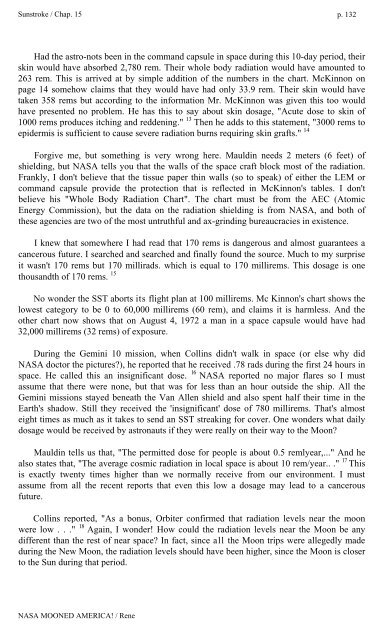Rene-NASA-Mooned-America
Rene-NASA-Mooned-America
Rene-NASA-Mooned-America
You also want an ePaper? Increase the reach of your titles
YUMPU automatically turns print PDFs into web optimized ePapers that Google loves.
Sunstroke / Chap. 15 p. 132<br />
Had the astro-nots been in the command capsule in space during this 10-day period, their<br />
skin would have absorbed 2,780 rem. Their whole body radiation would have amounted to<br />
263 rem. This is arrived at by simple addition of the numbers in the chart. McKinnon on<br />
page 14 somehow claims that they would have had only 33.9 rem. Their skin would have<br />
taken 358 rems but according to the information Mr. McKinnon was given this too would<br />
have presented no problem. He has this to say about skin dosage, "Acute dose to skin of<br />
1000 rems produces itching and reddening." 13 Then he adds to this statement, "3000 rems to<br />
epidermis is sufficient to cause severe radiation burns requiring skin grafts." 14<br />
Forgive me, but something is very wrong here. Mauldin needs 2 meters (6 feet) of<br />
shielding, but <strong>NASA</strong> tells you that the walls of the space craft block most of the radiation.<br />
Frankly, I don't believe that the tissue paper thin walls (so to speak) of either the LEM or<br />
command capsule provide the protection that is reflected in McKinnon's tables. I don't<br />
believe his "Whole Body Radiation Chart". The chart must be from the AEC (Atomic<br />
Energy Commission), but the data on the radiation shielding is from <strong>NASA</strong>, and both of<br />
these agencies are two of the most untruthful and ax-grinding bureaucracies in existence.<br />
I knew that somewhere I had read that 170 rems is dangerous and almost guarantees a<br />
cancerous future. I searched and searched and finally found the source. Much to my surprise<br />
it wasn't 170 rems but 170 millirads. which is equal to 170 millirems. This dosage is one<br />
thousandth of 170 rems. 15<br />
No wonder the SST aborts its flight plan at 100 millirems. Mc Kinnon's chart shows the<br />
lowest category to be 0 to 60,000 millirems (60 rem), and claims it is harmless. And the<br />
other chart now shows that on August 4, 1972 a man in a space capsule would have had<br />
32,000 millirems (32 rems) of exposure.<br />
During the Gemini 10 mission, when Collins didn't walk in space (or else why did<br />
<strong>NASA</strong> doctor the pictures), he reported that he received .78 rads during the first 24 hours in<br />
space. He called this an insignificant dose. 16 <strong>NASA</strong> reported no major flares so I must<br />
assume that there were none, but that was for less than an hour outside the ship. All the<br />
Gemini missions stayed beneath the Van Allen shield and also spent half their time in the<br />
Earth's shadow. Still they received the 'insignificant' dose of 780 millirems. That's almost<br />
eight times as much as it takes to send an SST streaking for cover. One wonders what daily<br />
dosage would be received by astronauts if they were really on their way to the Moon<br />
Mauldin tells us that, "The permitted dose for people is about 0.5 remlyear,..." And he<br />
also states that, "The average cosmic radiation in local space is about 10 rem/year.. ." 17 This<br />
is exactly twenty times higher than we normally receive from our environment. I must<br />
assume from all the recent reports that even this low a dosage may lead to a cancerous<br />
future.<br />
Collins reported, "As a bonus, Orbiter confirmed that radiation levels near the moon<br />
were low . . ." 18 Again, I wonder! How could the radiation levels near the Moon be any<br />
different than the rest of near space In fact, since all the Moon trips were allegedly made<br />
during the New Moon, the radiation levels should have been higher, since the Moon is closer<br />
to the Sun during that period.<br />
<strong>NASA</strong> MOONED AMERICA! / <strong>Rene</strong>


